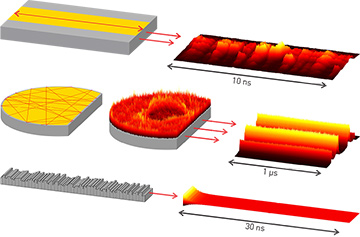 Top: A conventional broad-area laser with stripe-shaped gold contact and cleaved facets (left) features a measured spatio-temporal emission pattern exhibiting nanosecond-scale fluctuations (right). Middle: A D-cavity with chaotic ray dynamics (left), a typical passive cavity mode exhibiting a speckle-like structure (center) and a measured spatio-temporal emission pattern without fast fluctuations (right). Bottom: One-dimensional cavity with randomly varying refractive index (left) and its stable laser emission (right). [Enlarge figure]
Top: A conventional broad-area laser with stripe-shaped gold contact and cleaved facets (left) features a measured spatio-temporal emission pattern exhibiting nanosecond-scale fluctuations (right). Middle: A D-cavity with chaotic ray dynamics (left), a typical passive cavity mode exhibiting a speckle-like structure (center) and a measured spatio-temporal emission pattern without fast fluctuations (right). Bottom: One-dimensional cavity with randomly varying refractive index (left) and its stable laser emission (right). [Enlarge figure]
High-power semiconductor lasers are widely used for machining, laser surgery, lidar systems and large-scale displays. But high power levels require broad-area cavities, and the nonlinear interaction of many transverse modes with the active medium leads to self-organized spatiotemporal structures, such as filaments, that are prone to modulational instabilities.1
The ensuing fluctuations of output power and beam profile present a severe problem for applications. Conventional approaches for stabilizing these lasers try to limit the system’s complexity by reducing the number of transverse modes.2 Additional transverse modes and thus instabilities frequently re-emerge, however—for example, as pump power is increased.
This year, we proposed a counterintuitive solution for stabilizing high-power semiconductor lasers: embracing complexity instead of fighting it. In addition to the nonlinear interaction between light and gain medium, we introduced a complex cavity structure by replacing the conventional Fabry-Pérot-type cavities with deformed microcavities, or adding random subwavelength-scale fluctuations of the refractive index in the cavities.3 The chaotic ray dynamics in deformed cavities and the multiple scattering in a randomly structured cavity lead to complex wave interference, which yields speckle-like intensity distributions.4 This, in turn, disrupts the formation of self-organized structures and prevents spatio-temporal instabilities.
We demonstrated the effectiveness of this approach experimentally with D-shaped, edge-emitting semiconductor lasers and numerically in simulations of 1-D randomly structured semiconductor lasers.3 Remarkably, the nanosecond-timescale fluctuations that are typical for conventional broad-area semiconductor lasers were completely suppressed.
Our scheme of using cavity geometry or structural disorder to stabilize spatiotemporal instabilities has proved very effective and robust to fabrication imperfections, since these do not qualitatively change the already pseudo-random structure of the cavity modes. Moreover, multimode lasing is maintained, so this solution is inherently compatible with high-power operation, which naturally leads to multimode lasing.
We believe that this new paradigm for stabilization may be adapted to other laser types such as VCSELs, fiber and solid-state lasers. And the idea of manipulating and controlling the dynamics of nonlinear wave-dynamical systems by means of complex geometries could conceivably find applications in other fields, such as nonlinear optics or turbulent fluid dynamics.
Researchers
Stefan Bittner, Hasan Yılmaz, Kyungduk Kim and Hui Cao, Yale University, Conn., USA
Stefano Guazzotti, Sang Soon Oh and Ortwin Hess, Imperial College London, U.K.
Yongquan Zeng, Xiaonan Hu and Qi Jie Wang, Nanyang Technological University, Singapore
References
1. I. Fischer et al. Europhys. Lett. 35, 579 (1996).
2. J. Othsubo. Semiconductor Lasers—Stability, Instability and Chaos (Springer, 2017).
3. S. Bittner et al. Science 361, 1225 (2018).
4. H. Cao et al. Rev. Mod. Phys. 87, 61 (2015).

